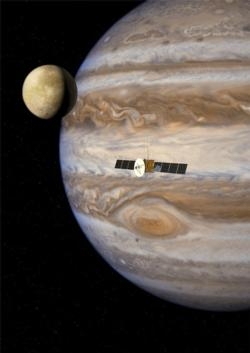Will Contribute UV Spectrometer, Radar, And Particle Environment Package
NASA has selected key contributions to a 2022 European Space Agency (ESA) mission that will study Jupiter and three of its largest moons in unprecedented detail. The moons are thought to harbor vast water oceans beneath their icy surfaces. NASA's contribution will consist of one U.S.-led science instrument and hardware for two European instruments to fly on ESA's Jupiter Icy Moons Explorer (JUICE) mission. JUICE will carry 11 experiments developed by scientific teams from 15 European countries, the United States and Japan.

The spacecraft will orbit Jupiter for three years and travel past its moons Callisto and Europa multiple times, then orbit Ganymede, a moon larger than the planet Mercury. JUICE will conduct the first thorough exploration of Jupiter since NASA's Galileo mission from 1989-2003. By studying the Jupiter system, JUICE will look to learn more about the formation and evolution of potentially habitable worlds in our solar system and beyond.
"NASA is thrilled to collaborate with ESA on this exciting mission to explore Jupiter and its icy moons," said John Grunsfeld, NASA's associate administrator for Science in Washington. "Working together with ESA and our other international partners is key to enabling future scientific progress in our quest to understand the cosmos."
The solar-powered spacecraft will carry cameras and spectrometers, a laser altimeter and an ice-penetrating radar. The mission also will carry a magnetometer, plasma and particle monitors, and radio science hardware. The spacecraft is scheduled to arrive at the Jupiter system in 2030. "The selection of JUICE's instruments is a key milestone in ESA's flagship mission to the outer solar system, which represents an unprecedented opportunity to showcase leading European technological and scientific expertise," said Alvaro Gimenez Canete, ESA's director of science and robotic exploration.
NASA invited researchers in 2012 to submit proposals for NASA-provided instruments for the mission. Nine were reviewed, with one selected to fly. NASA agreed to provide critical hardware for two of the 10 selected European-led instruments. NASA's total contribution to the JUICE mission is $100 million for design, development, and operation of the instruments through 2033.
The NASA contributions are:
- Ultraviolet Spectrometer: The principal investigator is Randy Gladstone of Southwest Research Institute in San Antonio. This spectrometer will acquire images to explore the surfaces and atmospheres of Jupiter's icy moons and how they interact with the Jupiter environment. The instrument also will determine how Jupiter's upper atmosphere interacts with its lower atmosphere below, and the ionosphere and magnetosphere above. The instrument will provide images of the aurora on Jupiter and Ganymede.
- Radar for Icy Moon Exploration: The principal investigator is Lorenzo Bruzzone of Universita degli Studi di Trento in Italy. The U.S. lead is Jeffrey Plaut of NASA's Jet Propulsion Laboratory (JPL) in Pasadena, Calif. Under the lead of Bruzzone and the Italian Space Agency, JPL will provide the transmitter and receiver hardware for a radar sounder designed to penetrate the icy crust of Europa, Ganymede, and Callisto to a depth of about 5 miles (9 kilometers). This will allow scientists to see for the first time the underground structure of these tectonically complex and unique icy worlds.
- Particle Environment Package: The principal investigator is Stas Barabash of the Swedish Institute of Space Physics. The U.S. lead is Pontus Brandt of the Johns Hopkins University Applied Physics Laboratory (APL) in Laurel, Md. Under the lead of Barabash and the Swedish National Space Board, APL will provide instruments to this suite to measure the neutral material and plasma that are accelerated and heated to extreme levels in Jupiter's fierce and complex magnetic environment.
NASA's Science Mission Directorate conducts a wide variety of research and scientific exploration programs for Earth studies, space weather, the solar system, and the universe. The New Frontiers Program Office at NASA's Marshall Space Flight Center in Huntsville, Ala., will manage the NASA contributions. JUICE is the first large-class mission in ESA's Cosmic Vision 2015-2025 Program.
(JUICE image provided by ESA)
 ANN's Daily Aero-Term (04.24.24): Runway Lead-in Light System
ANN's Daily Aero-Term (04.24.24): Runway Lead-in Light System ANN's Daily Aero-Linx (04.24.24)
ANN's Daily Aero-Linx (04.24.24) Aero-FAQ: Dave Juwel's Aviation Marketing Stories -- ITBOA BNITBOB
Aero-FAQ: Dave Juwel's Aviation Marketing Stories -- ITBOA BNITBOB Classic Aero-TV: Best Seat in The House -- 'Inside' The AeroShell Aerobatic Team
Classic Aero-TV: Best Seat in The House -- 'Inside' The AeroShell Aerobatic Team Airborne Affordable Flyers 04.18.24: CarbonCub UL, Fisher, Affordable Flyer Expo
Airborne Affordable Flyers 04.18.24: CarbonCub UL, Fisher, Affordable Flyer Expo



